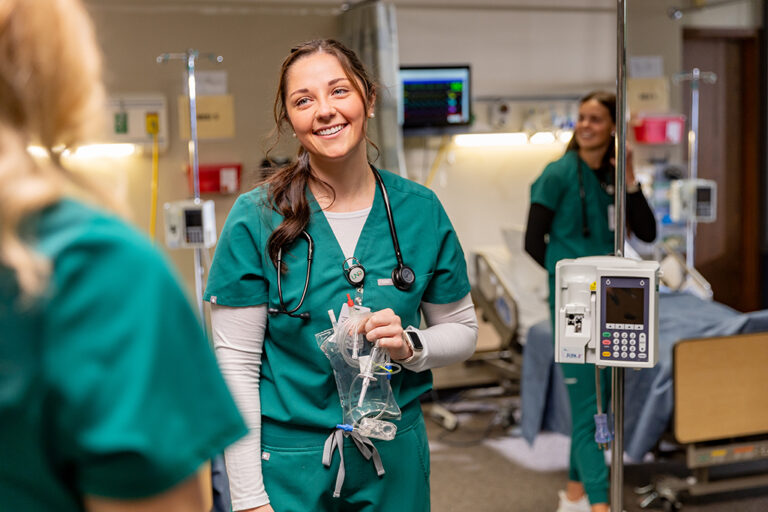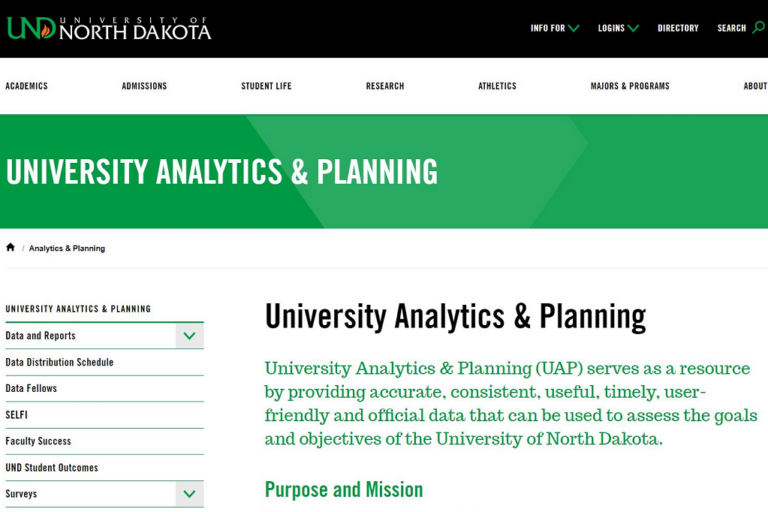Simulators on campus: Aerospace students ‘fly’ at zero altitude
Simulators are perfect for hands-on learning and practicing emergency procedures — and UND makes full use of them
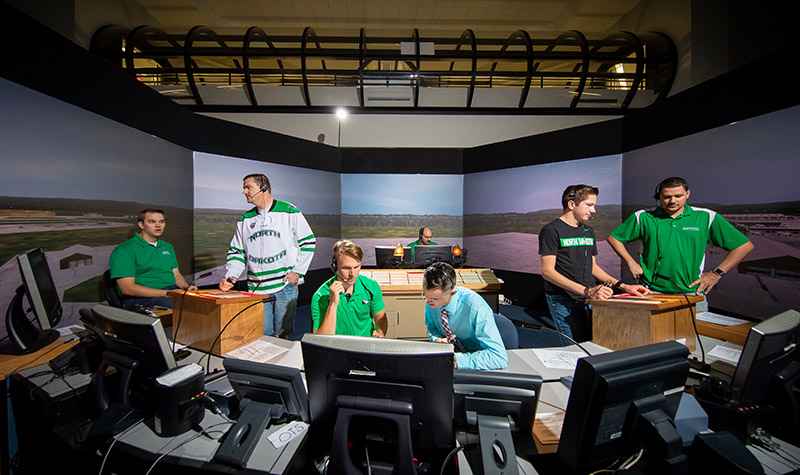
Editor’s note: It all started at the Link Piano and Organ Co.
That’s where Ed Link Jr., son of the founder of the Binghamton, N.Y.-based company, learned about pumps, bellows and valves. In 1929, Link used those skills to develop the Link Trainer, aka the Blue Box, a pneumatically controlled cockpit that moved in response to the pilot’s actions.
It was the world’s first flight simulator, and the rest is history.
In this story, UND Today notes how that history is playing out at the John D. Odegard School of Aerospace Sciences, where UND students use simulators at every stage of pilot and air-traffic-control training.
********
By the time young pilots graduate from UND, they’re ready for the next step in their careers.
Of course, that readiness comes from hour after hour of time behind the yoke of a real aircraft. Instructors put students through the paces of how to handle a myriad of situations, even some less than ideal, given the region’s extreme weather.
But what about real emergencies? For example, how can an instructor safely cut the engine — to emulate a failure — while approaching a landing?
That’s where state-of-the-art simulators come in.
“We can do things you wouldn’t want to practice in the aircraft, but still where it’s important to have that knowledge,” said Matt Opsahl, assistant chief flight instructor, with a bank of Frasca flight simulators behind him. The large, dark room seemed lit solely by trios of projectors, each set providing a mockup cockpit (where students and instructors sat side by side) with a virtual field of view.
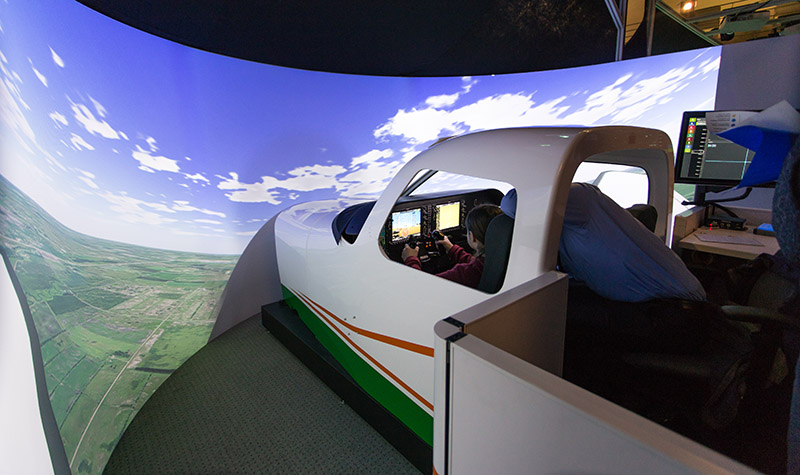
All of the room’s two-seat setups were new within the past three years, Opsahl said. Each shell of a cockpit, accompanied by a full instrument panel, sits inside a tall cubicle. Outside, a computer station controls the simulation.
Precise satellite imagery skirted by in its projection as someone banked the aircraft. The skies were crystal blue and the ground an emerald green, a far cry from the snows of January that sat outside of the building.
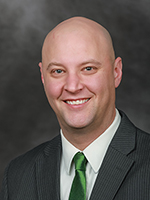
That’s the other big benefit of aircraft simulation technology: it’s impossible to be weathered out. Opsahl referred to “No Fly November” in a way that implied the nickname is common in the classrooms and hallways of UND Aerospace.
“That transition between fall and winter is always the worst,” remarked Opsahl, noting the season’s high winds and freezing rain. There are plenty of days when taking off from UND’s side of the Grand Forks airport in such a light aircraft would be irresponsible; but thanks to simulators, students not only can “fly,” they can do so in all conditions.
Of course, “a student can’t really jump around the curriculum and save the indoor sessions for when the weather is bad,” Opsahl said. Moreover, “the plus side of the weather we have here is it’s an experience you’re not going to get anywhere else.”
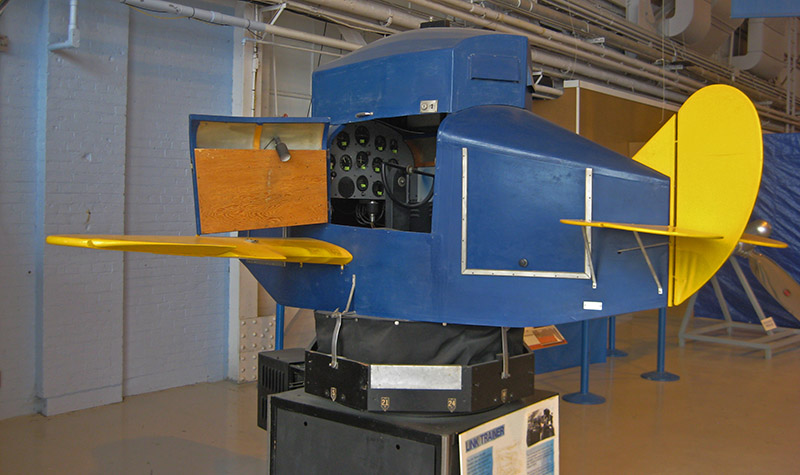
Venturing deeper into Ryan Hall leads to the School’s crosswind trainer. The device looks like the bottom half of a small cockpit with a control panel behind it. Sitting in the cockpit, the pilot faces a large monitor. The setup lets students practice the same scenario repeatedly: landing the aircraft in high winds.
“The instructor puts them on a final approach, sets the winds and gusts, then lets the student go,” Opsahl said. The training device fully articulates the simulation’s outputs, so the half cockpit lists and twists with three-axis movement as the “winds” try to blow the pilot off his or her approach.
Like a Navy pilot after a carrier landing, the pilot gets scored for the crosswind-trainer landing based on how well it went.
“It’s been invaluable,” Opsahl continued. “We’ve gotten good feedback from the students, who say it’s been really helpful learning how to do a good crosswind landing approach.”
The school’s Canadian Regional Jet training device dwarfs the crosswind trainer, requiring a much larger room. The device offers a 220-degree projection for students getting familiar with what they’ll most likely be flying after their time at UND.
The CRJ cockpit in Ryan Hall is what one would see on most commercial flights in and out of Grand Forks, Opsahl said.
As with the Frascas, CRJ trainees practice emergency scenarios and put their paper knowledge to the test. The galaxy of lights, buttons and dials in the cockpit would certainly be intimidating to the uninitiated.
One thing all of the above simulators have in common is that they’re open. When students sit behind the massive control panel of the CRJ cockpit, their backs are exposed to the room behind them. The same goes for the Frasca devices or the crosswind trainer.
But the spatial disorientation trainer almost literally flips that condition on its head. The device is fully enclosed and meant to put students through stomach-turning scenarios, mounted as it is on a three-axis rotation system.
Technicians Bob Kunze and Eric Toutenhoofd were delighted to show its capabilities. “There are situations pilots can find themselves in where their inner ear is telling them something that the aircraft is not physically doing,” Toutenhoofd said. “And if they react to that, they can put the aircraft into uncontrollable situations.”
In other words, trust your instruments. Opsahl got inside and went through a scenario of approaching and landing in total darkness. All he was able to see were the lights lining the simulated runway. Meanwhile, Kunze and Toutenhoofd ran the simulator and tracked everything Opsahl did, as well as what he could see through their own display.
An experienced pilot, Opsahl went through the exercise with little difficulty. But understanding the sensations of spatial disorientation is key to flight safety, he said.
Air Traffic Control
Not long after student pilots step into their flight simulators, they use simulation to learn what’s happening behind the scenes.
Colt Iseminger is the Air Traffic Management program’s laboratory simulation manager, as well as an instructor. Since 2012, he’s worked with the aircraft control simulation technologies in both Ryan and Clifford halls.
“Every aviation major has to take Introduction to Air Traffic Control,” Iseminger said. “We give them the chance to have time on the radar simulator so they get an idea of what controllers actually do. They typically realize it’s a lot different than they thought.”
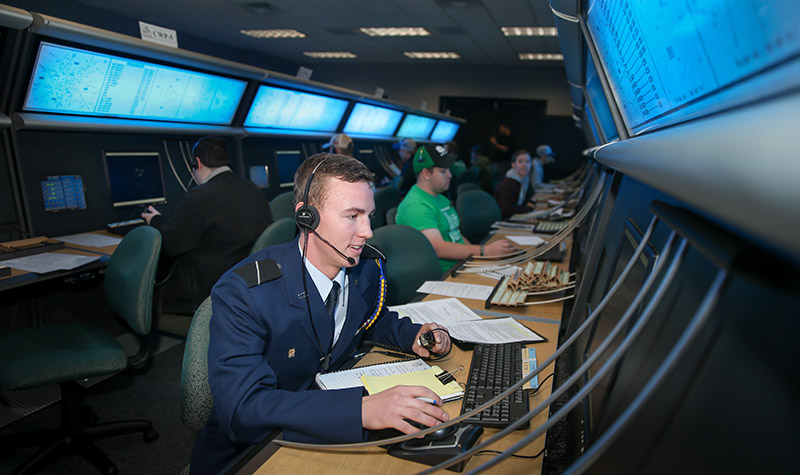
Students’ first stop is typically the program’s 32-position radar lab in Ryan Hall. In the same building is a 225-degree control tower simulator.
Meanwhile, Clifford Hall houses the 360-degree tower simulator, where students track, spot, talk with and control virtual aircraft as the planes approach, land, taxi and take off in real time.
As part of these hands-on courses, UND teaches the old way of doing things: pen and paper. Students learn how to manage air traffic by math and maps because they need the ability to fall back on the fundamentals, in case technology fails.
But Clifford Hall’s 360-degree tower represents the ultimate experience for a controller-in-training — a place where the pen and paper know-how meets experiential coursework. It’s a hub of activity during an upper-level class session, in this case led by Paul Drechsel, associate professor and director of UND’s program.
Iseminger pointed to a bank of computer stations outside of the main tower room, where other students fly the virtual airplanes for the simulation in response to radio requests by the controllers.

“We’re running one giant scenario right now,” explained Iseminger as students worked with one another, and teaching assistants stood over-shoulder. “When the radar station gets the ‘pilots’ on final approach, they tell them to contact the tower. The pilots actually switch to a different frequency and start talking to the tower.”
Once inside the tower, the scenes projected on each wall create a sense of being at an actual airport and in an actual tower. Drechsel was at the main console that day, looking over the six or seven students manning the tower’s four positions — two on ground control and two managing the runway.
UND is one of 31 schools partnered with the FAA in its Collegiate Training Initiative program. It’s designed to provide qualified candidates for federal positions controlling domestic airspace.
And as with most matters related to aviation, UND goes above and beyond preparing students for the next step. At the FAA Academy in Oklahoma City, where controllers go for official training, graduates of UND’s program routinely pick up on the advanced instruction more quickly than those with less experience, Iseminger said.
“Students leave here with a very good base knowledge of air traffic control operations, and they can build on that,” he continued. “We’ve had a very good success rate at the Academy.”
UAS
Not only do aviation students need to be exposed to air traffic controlling, but also they need to know what’s in store.
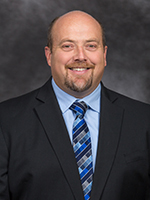
“We really want to expose all students to unmanned aircraft systems,” said Paul Snyder, director of UND’s UAS program. “Now we have 200 students every semester taking an Introduction to UAS course. It’s the future, so we want them to understand it and have an idea of what the industry is doing.”
And, as with the introduction to air traffic control, simulation is a key element of the course curriculum in UAS.
Of course, UAS operations already are almost all computerized in the real world. So, walking into a UAS simulation lab at UND is like walking into a computer lab in any other campus building, albeit with higher-performing hardware. Joysticks at the stations aren’t even used for flying; they’re used to control the cameras aboard simulated UAS platforms, Snyder said.
The software UND uses for UAS training comes from Simlat, an Israeli company with a fitting slogan: Any Platform, Any Payload, Any Mission.
“We have the potential to do so much with the software,” Snyder said. “Our ‘Intro’ students get into it and start to see how UAS is going to be used for the betterment of many industries.”
At the lab in Odegard Hall, all 25 computers equipped with Simlat can integrate with an instructor station, which provides the guidelines for any given scenario before students go about plotting their courses and establishing their mission plans.
Then after about 20 hours of simulated flight, students control UND’s Boeing Insitu ScanEagle – a small, long-range, pneumatically launched UAV – for about three.
“When you’re in a ground control station, it all looks the same as a simulation. It’s the same software,” Snyder remarked.
“But when they say, ‘launch, launch launch,’ there’s actually going to be someone pulling a cord, and the plane will launch. But what students are going to experience is exactly like the simulation. It’s going to feel the same way.”

